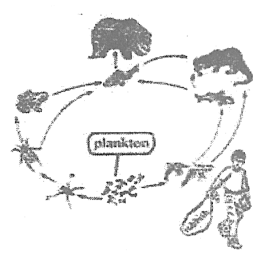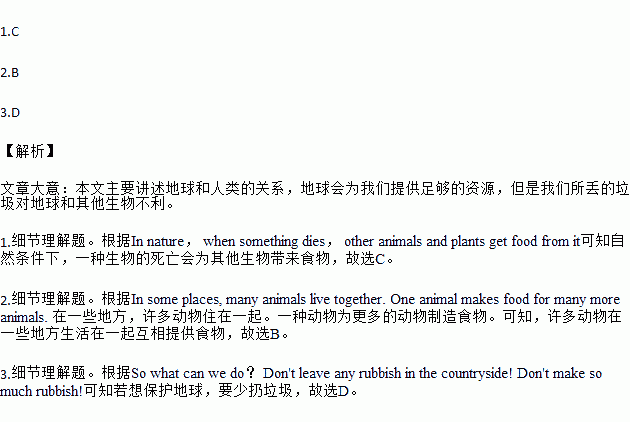题目内容

The population of the Earth is growing faster. It is important that we look after the Earth. We need it!
The Earth gives us a lot of things. We also give the Earth a lot, but some of the things are not good.
In nature, when something dies, other animals and plants get food from it. Every animal or plant gives food for other animals or plants. However, animals can't get food from many of the things that we “give” the Earth. Animals and plants can't eat metal, plastic and glass. These things will stay in the ground for many, many years.

Some rubbish is very dangerous for plants and animals. In some places, many animals live together. One animal makes food for many more animals. If we put rubbish and chemicals (化学制品) in the water, the plankton(浮游生物) can die. If there isn't any plankton, many animals have nothing to eat.
So what can we do? Don't leave any rubbish in the countryside! Don't make so much rubbish!
1.When something dies in nature, _________.
A.water and grass are polluted B.plastic and wood become food
C.other animals and plants get food D.metal and glass stay in the ground
2.Many animals live together in some places to _________.
A.clean the rubbish and chemicals B.provide food to each other
C.eat the plankton D.get warm from each other
3.We must __________to look after the Earth.
A.put metal in the ground B.use more wood
C.keep frogs in the water D.make less rubbish
Readers The show invites different people to read aloud on the stage. It tells the moving stories behind those people. At the same time, it shows us how important reading is in our daily life Channel: CCTV! Producer & Hostess: Doing Qing Time: 8:00 p.m.- 9:00 p.m. on Friday & Sunday |
Everlasting Classics《经典咏流传》 In this show, we can know many classic poems at different times. And many popular singers give us great performances by singing the poems. In this way, we can know our rich poetry(诗歌) culture better. Channel: CCTV1 Host: Sa Beining Time: 8:00 p.m.-9:00 p.m. on Saturday |
1.What does Doing Qing do?
A.A director and designer. B.A director and producer. C.A producer and hostess.
2.When is Everlasting Classics on?
A.8:00 p.m.-9:00 p. m on Friday.
B.8:00 p.m.-9:00 p.m. on Sunday.
C.8:00 p.m.-9:00 p.m. on Saturday
In common with many countries, Britain has serious environmental problems. In 1952, more than 4,000 people died in London because of the smog. The government introduced new laws to stop smog from coal fires and factories and the situation improved a lot.
Today, London is much cleaner but there is a new problem: smog from cars. In December 1991, there was very little wind in London and pollution increased a lot. As a result, about 160 people died from pollution in just four days.
Part of the problem is the new “out of town” shopping centers. In the past, people often walked to shops near their home or went by bus. Now, many people drive to the new shopping centers. As a result, the small shops have disappeared and more people have to travel to do their shopping.
Critics (评论员)say that Britain needs better and cheaper public transport. Transport in Britain is very expensive. An early morning train trip from Glasgow to London (about 600 km) can cost about 100 pounds, for example. A short 15-minute bus trip can cost over 1.00 pound.
Many people are trying to reduce the use of cars in Britain. Some cities now have special bicycle paths and many people cycle to work. Some people also travel to work together in one car to reduce the pollution and the cost.
Environmental problems in1. | |||
Time | Causes | Results | Solutions |
In the past | Smog from coal 2. And factories. | 3.4,000 people died in 1952. | New laws were introduced. |
Today | Smog caused by 4.. | About 160 people died in a few days in 1991. | ●Provide5.and cheaper public transport. ●Build special paths for bicycles. |


